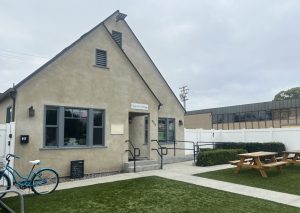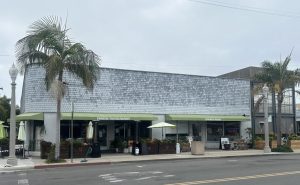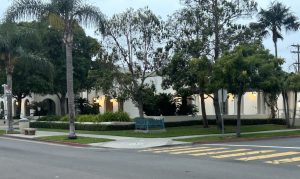The Coronado City Council has adopted a new housing element, approving zoning changes needed to make room for the 912 new housing units it is responsible for under the current Regional Housing Needs Allocation.
It was an expected move, but not one that city leaders relished.
“We no longer have local control,” Coronado Mayor Richard Bailey said after the votes of approval on April 9. “We have the appearance of local control that’s subject to the whims of Sacramento and SANDAG.”
The entire council agreed: the plan was not one that aligned with their vision for Coronado, but the city must comply with state law.
The state’s Department of Housing and Community Development (HCD) assigns Regional Housing Needs Allocations (RHNAs) in eight-year cycles, before the San Diego Association of Governments (SANDAG) divides its regional allocation among cities.
Coronado spent the early years of the current housing cycle fighting its allocation in court, but ultimately lost. After a failed appeal, the state’s Supreme Court declined to hear the case, and the HCD in 2022 warned Coronado it would face litigation if it did not comply.
With its options exhausted, the city then worked with the state to develop a compliant plan that makes room for 912 units (plus a mandated 15 percent buffer).
Coronado’s revised housing element was due in 2021, and noncompliance risks fines, loss of local zoning control, and the builder’s remedy provision, which allows developers to bypass a city’s zoning and general plan if the city is out of compliance with the HCD.
The HCD in a letter on April 9 indicated that its current plan met the state’s requirements. With City Council’s approval, the housing element will next be reviewed by the California Coastal Commission, a process that could take up to a year, before changes take effect.
City leaders say they don’t have much choice in the matter, but do consider part of the final plan a victory: Coronado was able to receive credit for 374 units of new barracks housing the U.S. Navy plans to build, which has never before been permitted.
Changes to zoning, density, and parking
Ultimately, the new housing element plan will do several things: First, it will change zoning at the various opportunity sites the city identified to fit its housing quota. (The sites and their changes are described in detail at the end of this article.)
Second, the new housing element will change all R-3-zoned properties from a 2-story, 33-foot maximum to a 3-story, 36 foot height maximum. However, allowed density will not change, so while buildings may get taller in these areas, more housing units will not follow.
“The HCD’s position on this one is that for every 10 dwelling units per acre of density, you must have one story and 12 feet of height,” said Richard Grunow, the city’s director of community development, redevelopment services and housing. That would mean that R-3 zoning would need the increased height limits in order to develop to full capacity.
“They view our limits as a constraint on development,” Grunow said. “That is one of the things that housing elements historically will evaluate, but this (requirement) did come as a bit of a surprise to us because it does not produce more housing.”
The zoning changes will also will reduce parking requirements for all one-bedroom and studio apartments in the city, whether they are affordable or market rate housing. The city currently requires two spaces per unit, and the new housing element reduces it to one.
Further, it stipulates a developer incentive that all units designated as affordable, regardless of their size, will qualify for a density bonus that reduces its parking allocation to one space per unit.
Many members of the public questioned the parking reduction at 105 B Ave., which currently hosts a Smart & Final Extra! That site was discussed at length at last week’s planning commission meeting, in which the board voted against the housing element update on principle. Again, however, city leaders say they cannot fight state laws.
Predictably, many people during public comment spoke against the zoning changes. Parking and congestion were a chief concern.
“Today, we have to balance your views with what the state requires,” City Council Member Casey Tanaka said, noting that some of the changes the HCD required, like the changes to the parking rules, are “nonsensical.”
“Some of the things that we might end up supporting are not the types of public policy I would ever campaign on,” he added. “But I would also not campaign on violating state law. And I would also not campaign on losing control of our city.”
In addition to parking, another concern from residents was infrastructure. Parking can be hard to come by, and the city’s stormwater infrastructure was strained during a Jan. 22 rainstorm that caused flooding in the city.
Again, city leaders said they understood the concerns, but this was not something they could control.
“The state rules and the specific language that’s included in regard to our allocation specifically stay that a city’s lack of infrastructure is not a defense to creating a housing element for these numbers,” said City Council Member John Duncan, “unless the infrastructure or the lack thereof is due to an outside agency such as the federal government preventing it.”
Other requirements from the state include allowing emergency shelters by-right in the R-4 zone. The city must also complete ongoing tasks that state says will promote affordable housing, such developing pre-approved ADU plans and increasing the city’s affordable housing in-lieu fee, which is assessed when developers fail to set aside at least 20% of its dwelling units as affordable housing. Currently, that fee is $7,000 per market-rate unit.
The exclusion of small lots as opportunity sites
Several residents questioned why the city only considered parcels that are half an acre or larger as opportunity sites, echoing discussions at last week’s Planning Commission meeting.
Although state guidelines say that, in general, a parcel must be that size to reasonably accommodate affordable housing, the state’s Housing Element Site Inventory Guidebook says some exceptions can be made for smaller lots. Another exception is lots that are owned by the city.
A small lot may be accepted as part of a housing element with enough evidence that affordable housing were feasible. Evidence could include developer interest, potential for lot consolidation, site analysis that proves the project is feasible, a pre-approved development plan, or densities that allow for affordable housing.
Grunow said that as the city worked with the HCD to develop its plan, city staff were told by the state to focus on larger lots.
“That presumption (that only larger lots will be approved) is built into the state law; it comes directly from the statute,” added Eric Phillips, the city’s special counsel for the housing element. “It could be a rebuttable presumption if there is specific evidence that affordable housing will develop over the next eight years, or could develop over the next eight years. But, as Director Grunow was describing, the state’s direction was to focus on sites that met the presumption that was in the statute, rather than trying to overcome that (parcel size restriction), because that would make it easier for the city to actually reach the state mandated housing numbers.”
Amy Melden, who owns property that did not qualify as an opportunity site, said it was unfair that the city did not conduct public outreach to determine whether any owners of smaller parcels were interested in developing their lots to state standards.
“There is a pathway through the state; I have talked to them,” Melden said. “But the city never did outreach.”
She said that she and others who own smaller lots wanted to be included as opportunity sites and would be able to develop affordable units on their parcels. She argued that the city should have pursued this avenue so that the new housing units were spread out, rather than consolidated at places like the Smart & Final Extra! site, further straining an already dense area of town.
“This is bad planning – terrible planning,” Melden said. “And if you haven’t reached out to those property owners in this vicinity (whose parcels) are less than a half acre, you haven’t done your job.”
City Council Member Carrie Downey thanked property owners who wanted to help reach the city’s affordable housing allocation and said that the next housing cycle is coming up fast, and suggested that those sites may be included in future allocations.
“That’s our next task: to figure out what it would really do to help us meet these goals,” she said. “Because when we come back in 2029, if we haven’t built any affordable housing in this housing cycle, the HCD will want some answers for the next one.”
Rezoning for additional units does not require that the units are built; that is left to the discretion of individual property owners.
“The state’s not saying you cannot build low income housing, except on these sites,” Council Member Mike Donovan said. “You can build it anywhere you want. The differentiation is, at this point in trying to get our housing element approved, (the HCD) won’t count any potential low-income sites, except the ones that we’re identifying here.”
Although the overall attitude toward the zoning changes was negative, both from city leaders and the public, some said that change, while uncomfortable, is needed to address California’s growing housing crisis.
“You should all vote to approve this housing element with joy in your hearts, knowing that you made the situation better, if only just a little bit,” said Glen Hopson, a Coronado homeowner. “Please make housing legal so we can build more, bring the housing prices down and do the best thing for sailors stationed here, public employees who want to work in the city they serve, and our adult children who want to raise their kids as Islanders.”
The opportunity sites and zoning changes
The city’s revised housing element relies on 374 units of barracks housing the Navy intends to build, plus the conversion of carriage houses as dwellings and the construction of additional accessory dwelling units (ADUs). The plan also includes nine opportunity sites, which will be rezoned to allow for more density:
 919 C Avenue: The 0.62-acre site is owned by the Parish of Christ Church.The parcel would have a total unit potential of 25, but a realistic capacity development of 19 units.
919 C Avenue: The 0.62-acre site is owned by the Parish of Christ Church.The parcel would have a total unit potential of 25, but a realistic capacity development of 19 units.
The owner is interested in developing affordable housing while retaining its thrift shop. The rezone would allow it to continue to operate its school facilities.
It will be rezoned from R-3 to R-4/HEI1, allowing for up to 40 dwelling units per acre, and four stories at 42 feet of height.
 517 Orange Avenue: Currently, a duplex sits on this 0.08-acre parcel, and it was recently purchased by the city with plans to convert it to affordable housing. It would replace two above moderate-income housing units with three lower-income housing units, for a net yield of one unit.
517 Orange Avenue: Currently, a duplex sits on this 0.08-acre parcel, and it was recently purchased by the city with plans to convert it to affordable housing. It would replace two above moderate-income housing units with three lower-income housing units, for a net yield of one unit.
It will be rezoned from R-4 to R-4/HE-1, allowing for four-story, 42-foot structure. However, its current density limit of 40 dwelling units per acre will be unchanged.
 1224 10th Street: This 0.55-acre parcel, which is walking distance from schools, grocery stores, and parks, is currently an office building. If rezoned, it could hold up to 22 units, but as it would allow for mixed use, the report assumes an actual 50% capacity. The yield: three lower income units and eight above moderate units.
1224 10th Street: This 0.55-acre parcel, which is walking distance from schools, grocery stores, and parks, is currently an office building. If rezoned, it could hold up to 22 units, but as it would allow for mixed use, the report assumes an actual 50% capacity. The yield: three lower income units and eight above moderate units.
It will be rezoned from C (commercial) to C/HE-2, which allows for four-story, 42-foot structures with 40 dwelling units per acre.
 1001 C Avenue: This 0.57-acre parcels currently hosts a retail property. The housing element would allow for mixed-use development, yielding three lower income units and eight above moderate income units.
1001 C Avenue: This 0.57-acre parcels currently hosts a retail property. The housing element would allow for mixed-use development, yielding three lower income units and eight above moderate income units.
The parcel will be rezoned from C to C/HE-2, which allows for four-story, 42-foot structures with 40 dwelling units per acre.
105 B Avenue: This proposed development site is 2.89 acres and comprises most of the block perimetered by 1st Street, B Avenue, 2nd Street, and C Avenue. If rezoned, it could generate up to 116 units, but the city projects a realistic development of 58 units. Of those, 15 would be lower income units.
The properties currently have retail and commercial businesses on them, including a Smart & Final Extra! and fast food restaurants.
“Local residents would like grocery use to continue on the site, and city staff will work with the owner/developer to incorporate a grocery component,” the house element plan reads.
It will be rezoned from C to C/HE-2, which allows for four-story, 42-foot structures with 40 dwelling units per acre. Currently, the site only allows for two stories and no dwelling units.
149 A Avenue: Currently a parking lot, this 1.28-acre parcel could yield up to 58 units if rezoned, but planners project a realistic development of 38 units. Of those, 15 would be lower income units.
It will be rezoned from R-PCD to R-PCD/HE2, which caps density at 60 dwelling units per acre for a 5-story, 50-foot structure.
1515 Second Street: This parcel already has a 549-unit apartment complex on it, but the 12.66-acre site has underutilized as well as parking lot space that could generate 167 new units. The report projects 12 would be lower income units, 55 would be moderate, and 100 would be above moderate.
It will be rezoned from R-PCD to R-PCD/HE2, which caps density at 60 dwelling units per acre for a 5-story, 50-foot structure.
 700 Orange Avenue: This 1.58-acre parcel, which currently houses the City of Coronado Police Department, could be rezoned for up to 63 housing units, though its projected actual development is 47 very low or low income units. All of these would be lower income units.
700 Orange Avenue: This 1.58-acre parcel, which currently houses the City of Coronado Police Department, could be rezoned for up to 63 housing units, though its projected actual development is 47 very low or low income units. All of these would be lower income units.
“Housing for very low income veterans is a potential affordable housing project,” the housing element, noting that the city owns most of the land and therefore is likely to yield 100 percent low-income housing.
It will be rezoned from CU/R4 to CU/R4/HE1, which caps density at 40 dwelling units per acre for a 4-story, 42-foot structure.
 201 6th Street: This CUSD-owned property is a former elementary school that closed due to lower enrollment. Now, it’s a childcare and pre-school center, but the district is “open” to develop housing for teachers, the housing element says. It projects 67 lower income units and 34 moderate income units, for a total of 101.
201 6th Street: This CUSD-owned property is a former elementary school that closed due to lower enrollment. Now, it’s a childcare and pre-school center, but the district is “open” to develop housing for teachers, the housing element says. It projects 67 lower income units and 34 moderate income units, for a total of 101.
It will be rezoned from CU to Cu/HE1, capping density at 40 dwelling units per acre in a 4-story, 42-foot structure.
A breakdown of the housing element’s projected new housing follows.
| Location | Very low/low income units | Moderate income units | Above moderate income units |
| 919 C Avenue | 19 | 0 | 0 |
| 517 Orange Ave | 3 | 0 | 0 |
| 1224 10th Street | 3 | 0 | 8 |
| 1001 C Ave | 3 | 0 | 8 |
| 150 B. Ave | 15 | 0 | 43 |
| 1515 2nd Street | 12 | 55 | 100 |
| 149 A Ave | 15 | 0 | 23 |
| 700 Orange Ave | 47 | 0 | 0 |
| 201 6th Street | 67 | 34 | 0 |
| Military Housing | 305 | 69 | 0 |
| ADUs | 117 | 25 | 53 |
| Carriage Houses | 72 | 0 | 31 |
| Totals | 678 | 183 | 266 |




